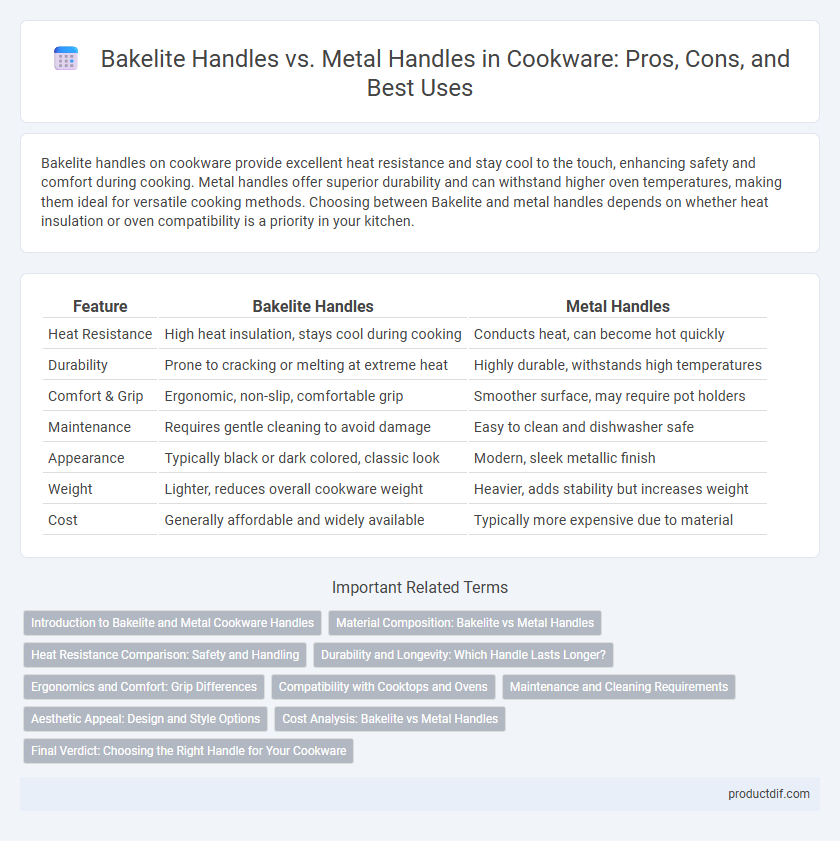Bakelite handles on cookware provide excellent heat resistance and stay cool to the touch, enhancing safety and comfort during cooking. Metal handles offer superior durability and can withstand higher oven temperatures, making them ideal for versatile cooking methods. Choosing between Bakelite and metal handles depends on whether heat insulation or oven compatibility is a priority in your kitchen.
Table of Comparison
| Feature | Bakelite Handles | Metal Handles |
|---|---|---|
| Heat Resistance | High heat insulation, stays cool during cooking | Conducts heat, can become hot quickly |
| Durability | Prone to cracking or melting at extreme heat | Highly durable, withstands high temperatures |
| Comfort & Grip | Ergonomic, non-slip, comfortable grip | Smoother surface, may require pot holders |
| Maintenance | Requires gentle cleaning to avoid damage | Easy to clean and dishwasher safe |
| Appearance | Typically black or dark colored, classic look | Modern, sleek metallic finish |
| Weight | Lighter, reduces overall cookware weight | Heavier, adds stability but increases weight |
| Cost | Generally affordable and widely available | Typically more expensive due to material |
Introduction to Bakelite and Metal Cookware Handles
Bakelite handles, made from a heat-resistant synthetic polymer, offer excellent insulation, preventing burns while cooking and remaining cool to the touch. Metal handles, typically crafted from stainless steel or aluminum, provide superior durability and can withstand high oven temperatures but may require protective mitts due to heat conduction. Choosing between Bakelite and metal cookware handles depends on cooking style, heat exposure, and safety preferences.
Material Composition: Bakelite vs Metal Handles
Bakelite handles are made from a thermosetting plastic that offers excellent heat resistance and electrical insulation, making them safe to touch during cooking. Metal handles, often crafted from stainless steel or aluminum, provide superior durability and can withstand higher oven temperatures but may require heat-resistant gloves as they conduct heat efficiently. Choosing between Bakelite and metal handles depends on whether heat insulation or oven resilience is the priority in cookware performance.
Heat Resistance Comparison: Safety and Handling
Bakelite handles exhibit superior heat resistance as they remain cool to the touch during cooking, significantly reducing the risk of burns and enhancing safety when handling hot cookware. Metal handles, while durable, tend to conduct heat quickly, necessitating the use of oven mitts or pot holders to prevent injuries. Choosing cookware with Bakelite handles ensures safer handling without compromising performance in high-temperature cooking environments.
Durability and Longevity: Which Handle Lasts Longer?
Bakelite handles offer excellent heat resistance and remain cool to the touch, but they may become brittle or crack over time with exposure to high temperatures and frequent use. Metal handles, especially those made from stainless steel or cast iron, provide superior durability and longevity, resisting warping, cracking, and corrosion even under intense cooking conditions. Choosing metal handles enhances cookware lifespan, making them a preferred option for long-term kitchen use.
Ergonomics and Comfort: Grip Differences
Bakelite handles offer superior heat resistance and a comfortable, cool grip, minimizing the risk of burns during extended cooking sessions, making them ideal for ergonomic use. Metal handles, while durable and often dishwasher safe, can become hot quickly, requiring additional protective gear like pot holders to ensure a secure grip. Ergonomically designed Bakelite handles often feature contoured shapes that enhance grip stability and reduce hand fatigue compared to the rigid structure of metal handles.
Compatibility with Cooktops and Ovens
Bakelite handles provide excellent heat insulation, making them safer for stovetop use but generally unsuitable for oven cooking due to their lower heat tolerance. Metal handles withstand higher temperatures, offering compatibility with both cooktops and ovens, including induction and ceramic surfaces. Choosing handles depends on cookware usage frequency and preferred cooking methods, with metal providing greater versatility across heat sources.
Maintenance and Cleaning Requirements
Bakelite handles require gentle cleaning with mild detergents to prevent cracking and discoloration, avoiding abrasive scrubbers or high heat exposure. Metal handles are more durable under intense cleaning, allowing for dishwasher use and high-temperature scrubbing without damage. Proper maintenance of Bakelite handles extends their lifespan, while metal handles offer easier upkeep for heavy-duty cookware cleaning.
Aesthetic Appeal: Design and Style Options
Bakelite handles offer a classic, matte finish that complements vintage and retro cookware designs, enhancing aesthetic appeal with their warm, tactile quality. Metal handles provide a sleek, modern look with options ranging from polished stainless steel to brushed aluminum, suitable for contemporary kitchen styles. The choice between Bakelite and metal handles influences not only function but also the overall visual harmony and style coherence of cookware collections.
Cost Analysis: Bakelite vs Metal Handles
Bakelite handles typically cost less due to the lower price of raw materials and simpler manufacturing processes compared to metal handles. Metal handles, often made from stainless steel or aluminum, incur higher production costs stemming from material expenses and machining or welding requirements. Choosing Bakelite handles can reduce upfront cookware costs, while metal handles may increase durability but lead to higher overall expenditure.
Final Verdict: Choosing the Right Handle for Your Cookware
Bakelite handles offer excellent heat resistance and stay cool during cooking, making them ideal for safe handling without oven use. Metal handles provide superior durability and are oven-safe, suitable for high-temperature cooking and broiling. Choosing the right handle depends on your cooking style, with bakelite handles preferred for stovetop use and metal handles favored for versatility and oven compatibility.
Bakelite Handles vs Metal Handles Infographic

 productdif.com
productdif.com